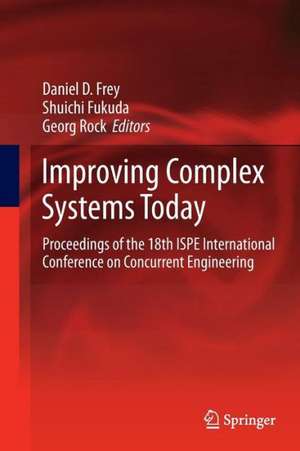Improving Complex Systems Today: Proceedings of the 18th ISPE International Conference on Concurrent Engineering: Advanced Concurrent Engineering
Editat de Daniel D. Frey, Shuichi Fukuda, Georg Rocken Limba Engleză Paperback – 27 noi 2013
The primary focus of concurrent engineering was, at first, on bringing downstream information as far upstream as possible by introducing parallel processing in order to reduce time to market and to prevent errors at a later stage which would sometimes cause irrevocable damage. Up to now, numerous new concepts, methodologies and tools have been developed, but over concurrent engineering’s 20-year history the situation has changed extensively. Now, industry has to work in the global marketplace and to cope with diversifying requirements and increasing complexities. Such globalization and diversification necessitate collaboration across different fields and across national boundaries. Thus, the new concurrent engineering calls for a systems approach to gain global market competitiveness. Improving Complex Systems Today provides a new insight into concurrent engineering today.
| Toate formatele și edițiile | Preț | Express |
|---|---|---|
| Paperback (1) | 1226.73 lei 6-8 săpt. | |
| SPRINGER LONDON – 27 noi 2013 | 1226.73 lei 6-8 săpt. | |
| Hardback (1) | 1233.06 lei 6-8 săpt. | |
| SPRINGER LONDON – 9 iul 2011 | 1233.06 lei 6-8 săpt. |
Preț: 1226.73 lei
Preț vechi: 1496.01 lei
-18% Nou
Puncte Express: 1840
Preț estimativ în valută:
234.77€ • 244.19$ • 193.81£
234.77€ • 244.19$ • 193.81£
Carte tipărită la comandă
Livrare economică 14-28 aprilie
Preluare comenzi: 021 569.72.76
Specificații
ISBN-13: 9781447126904
ISBN-10: 1447126904
Pagini: 508
Ilustrații: XXI, 484 p.
Dimensiuni: 155 x 235 x 27 mm
Greutate: 0.7 kg
Ediția:2011
Editura: SPRINGER LONDON
Colecția Springer
Seria Advanced Concurrent Engineering
Locul publicării:London, United Kingdom
ISBN-10: 1447126904
Pagini: 508
Ilustrații: XXI, 484 p.
Dimensiuni: 155 x 235 x 27 mm
Greutate: 0.7 kg
Ediția:2011
Editura: SPRINGER LONDON
Colecția Springer
Seria Advanced Concurrent Engineering
Locul publicării:London, United Kingdom
Public țintă
ResearchCuprins
Underestimation in the “When It Gets Worse Before it Gets Better” Phenomenon in Process Improvement.- Automation Tools Supporting the Development of Information Standards for Complex Systems.- Use of Structured Total Approach in Developing a System for Emergency Power Generation for Aircraft with Fly by Wire.- System CE of Space Payload Design Aquarius Instrument.- Systems CE for the Conception of an Attitude & Orbit Control System.- Systems CE of a Hypersonic Accelerator Vehicle.- Attributes Balance on the Adoption of Platform based Solutions for Satellites.- Petri Nets for Systems CE.- Systems Support Eng.: Looking Beyond The Physical.- Domain-Centred Functionalities Discovering for Testing Systems Functionalities.- Comparison of Domain-Centered & Context-Centered Systems Functionalities.- CE Applications & Lessons Learnt in Oil Refinery.- Analyzing Influence of Absence of CE on Pakistan’s Economy from Perspective of Developed Countries Using It.- Green Transportation Strategies & Impact Evaluation Using System Dynamic Modeling.- System Dynamics Evaluation of Renewable Energy Policies.- Initial sizing model of PV/battery system with battery scheduling algorithm.- Feature Performance Metrics for Software as a Service Offering.- Automating Services for Spacecraft Conceptual Design via an Enterprise Service Bus.- An Approach to Adapt Collaborative Architectures to Cloud Computing.- MimoSecco: A Middleware for Secure Cloud Storage.- Implementation of CE in Software Development.- Concurrent Planning Using Semantics-driven Reconciliation.- Research on Service Encapsulation of Eng. Software Based on Jini.- Ontology Development for the Integration of CAD Models in a Collaborative Environment.- Ontological Modelling of the Aerospace Composite Manufacturing Domain.- A Knowledge-Based Approach to Design Automation of Wire & Pipe Routing through Complex Aerospace Structures.- The Cluster Grouping Approach of NM Forecasting Model for BookPublishing.- A Prosthesis Design Based on Genetic Algorithms in the CE Context.- Conceptual Reasoning Model for Supporting Strategic Planning of Dental Implant Surgical Process.- Conceptual Designing Supported by Automated Checking of Design Requirements & Constraints.- Extended KBE in Mechanical Eng. – Discussion of Concepts.- Extended KBE in Mechanical Eng. – Discussion of Solutions.- Towards a Semantic Knowledge Life Cycle Approach for Aerospace Design Eng..- Regeneration of 3D Profile Line Using a Combination of Photo Images & Target Markers.- Virtual Reality-Based Lathe Operation Training Based on Brain Activity Assessment Using Functional Near-Infrared Spectroscopy.- Addressing Complexity in Sustainable Aircraft Design.- Balancing Value in Complex Systems Development.- Value Stream Analysis of Manufacturing Eng. New Product Introduction Processes.- Concurrent Product Development - Case Study of LED Linear Tube Lamp.- Concurrent Development of RIM Parts.- Preliminary Design within CE Using the MFF.- Proposal of a NPD Diagnostic Method to Identify Improvement Opportunities.- Reference Planning Processes for Series Production.- Accuracy Evaluation System for Shipbuilding Blocks Using Design Data & Point Cloud Data.- Design Support for “Suriawase”: Japanese Way for Negotiation among Several Teams.- Management Teamwork: Influence of Management vs. the Influence of Tools in Product Development Change.- Towards a Cost Modeling Framework for Outsourcing ERP Systems.- Activity-based costing model for MGPD.- Planning Manufacturing in a CE Environment: A Case Study.- CE yesterday, today & tomorrow.- Set-Based CE process within the LeanPPD environment.- Capacity Fade Model of Lithium-Ion Batteries for Practical Use.- COLOR & ILLUMINATION IN THE PROJECT OF INTERIOR AIRCRAFT.- KANSEI ENG.: METHODOLY TO THE PROJECT ORIENTED FOR THE COSTUMERS.- Effect of Tonal Harmonic Feature in Product Noise on Emotional Quality.- Pragmatic CE: Emotion,Experience & Eng..
Notă biografică
Daniel Frey is an associate professor of mechanical engineering and engineering systems at MIT and he is a leading researcher of design theory and methodology, especially in the field of quality technology and robust design. He has had extensive consulting experience with many industries. Therefore, he has a very good sense of proportion between theory and practice, and he received the Junior Bose Award for Excellence in Teaching at MIT. Thus, he is not only conducting cutting-edge research, but he is also very good at making materials comprehensible. He is now co-director of the MIT-Singapore University of Technology and Design Alliance and is making efforts to establish a new direction in research and education in design engineering.
Shuichi Fukuda held a workshop titled "Computer aided Cooperative Product Development" at MIT with Ram Sriram in 1989, at the same time as DARPA started their concurrent engineering "DICE" project. Thus, he is one of the pioneers in this field. He published the outcomes of this workshop with Ram Sriram and Robert Logcher as Lecture Note No.437 from Springer in 1991. He worked for a long time as an executive board member of the Engineering Information Management Systems group, ASME. He is now Chair of the Computers and Information in Engineering Division, ASME, which developed from this group. In addition, he served as Vice President at the IEEE Reliability Society, so his activities extend over wide areas. He is President of ISPE, which hosts the International Conference on Concurrent Engineering.
Shuichi Fukuda held a workshop titled "Computer aided Cooperative Product Development" at MIT with Ram Sriram in 1989, at the same time as DARPA started their concurrent engineering "DICE" project. Thus, he is one of the pioneers in this field. He published the outcomes of this workshop with Ram Sriram and Robert Logcher as Lecture Note No.437 from Springer in 1991. He worked for a long time as an executive board member of the Engineering Information Management Systems group, ASME. He is now Chair of the Computers and Information in Engineering Division, ASME, which developed from this group. In addition, he served as Vice President at the IEEE Reliability Society, so his activities extend over wide areas. He is President of ISPE, which hosts the International Conference on Concurrent Engineering.
Textul de pe ultima copertă
As the main theme of Improving Complex Systems Today implies, this book is intended to provide readers with a new perspective on concurrent engineering from the standpoint of systems engineering. It can serve as a versatile tool to help readers to navigate the ever-changing state of this particular field.
The primary focus of concurrent engineering was, at first, on bringing downstream information as far upstream as possible by introducing parallel processing in order to reduce time to market and to prevent errors at a later stage which would sometimes cause irrevocable damage. Up to now, numerous new concepts, methodologies and tools have been developed, but over concurrent engineering’s 20-year history the situation has changed extensively. Now, industry has to work in the global marketplace and to cope with diversifying requirements and increasing complexities. Such globalization and diversification necessitate collaboration across different fields and across national boundaries. Thus, the new concurrent engineering calls for a systems approach to gain global market competitiveness. Improving Complex Systems Today provides a new insight into concurrent engineering today.
The primary focus of concurrent engineering was, at first, on bringing downstream information as far upstream as possible by introducing parallel processing in order to reduce time to market and to prevent errors at a later stage which would sometimes cause irrevocable damage. Up to now, numerous new concepts, methodologies and tools have been developed, but over concurrent engineering’s 20-year history the situation has changed extensively. Now, industry has to work in the global marketplace and to cope with diversifying requirements and increasing complexities. Such globalization and diversification necessitate collaboration across different fields and across national boundaries. Thus, the new concurrent engineering calls for a systems approach to gain global market competitiveness. Improving Complex Systems Today provides a new insight into concurrent engineering today.
Caracteristici
Written by experts











